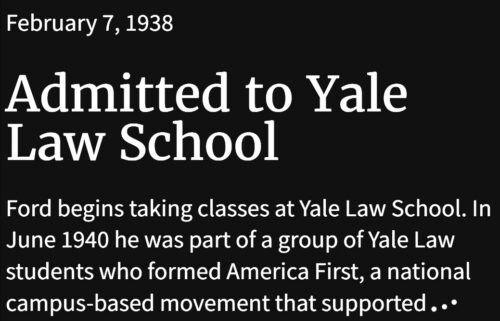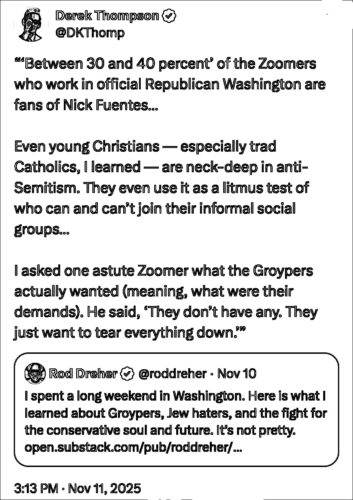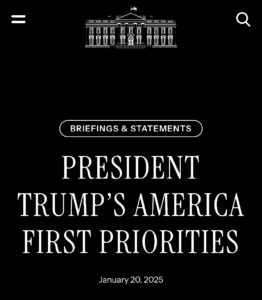MAGA’s U-turn takes America back to open white hate as federal policy after 70 years of encoding.
$300 million in private funding from America’s tech oligarchs is being funneled into Trump’s Hitler-esque marble ballroom on top of Franklin Roosevelt’s demolished wartime offices and bunker. 

Destroying the White House WWII wing and hosting a fascist ball on top of the bunker Roosevelt built to defeat Hitler? That’s not an accidental architectural placement. As Betty Ford allegedly put it:
If the West Wing is the mind of the nation, then the East Wing is the heart.

Trump just destroyed the heart of America, as he very narrowly targeted the legacy of Roosevelt and JFK for a “renewal” in Hitler’s image. That’s beyond Nixon, beyond even Reagan, this is the most extreme white nationalist President since Woodrow Wilson.

Nixon and Reagan used coded language and justified devastation with infrastructure “improvements”. Trump uses Wilson’s explicitly racist “America First” (KKK) branding and builds actual monuments to domestic terrorism and dictatorship. Nixon ran bulldozers through Black neighborhoods to enable “white flight” roads, Reagan ran “urban renewal” demolitions and expanded Nixon’s “war on drugs” racism. Trump has… plans to build Hitler’s marble and gold “ballroom.”
Trump is different because he’s returned to the dangerous nativist “America First” architectural playbook—the same one used for a century to position giant celebratory Klaverns on the ashes of successful community leaders (e.g. 1921 firebombing of Tulsa) and statues of the monstrous Robert E. Lee (e.g. reputation for raping girls) around schools and parks.

This is simply a reiteration of the explicit architectural playbook. The pattern is clear, the evidence is material, and the stakes are existential.
Part I: “America First” is White Nationalism
“America First” is not a slogan. It’s a late 1800s declaration of racial dominance with documented continuity from the end of the Civil War to President Wilson’s restart of the KKK, to American supporters of Hitler and Trump.
- 1882: President Arthur (after Garfield’s assassination) is violently coerced into 10 year ban on immigration (“exclusion”) among “America First” nativist xenophobic campaigns killing immigrants (Los Angeles Massacre of 1871, Rock Springs Massacre of 1885)
- 1915: Woodrow Wilson makes “America First” his campaign slogan and restarts the KKK. He screens “Birth of a Nation” in the White House, uses presidential power to promote “white hood” vigilantism, and makes white supremacy federal policy, removing Blacks from office. America First opposes “military preparedness” against Germany in WWI.

- 1915-1920s: “America First” used as rallying cry for militant white supremacist organizations nationwide. It’s not subtle, it’s still the brand for racist lynchings like in the 1800s.

Donald Trump’s father was arrested marching in a KKK parade where he fought with police. - 1940-1941: The America First Committee of white supremacists (e.g. founded by Gerald Ford, later hand-picked as VP by Nixon and then President without ever winning a national election) aligns with Hitler, actively working to undermine “military preparedness” against Germany in WWII. Roosevelt impanels a federal grand jury to investigate them as Nazi agents.

That supported… Hitler. Source: Gerald Ford Presidential Library - 1942: A federal grand jury rules the America First Committee is officially Nazi propaganda. Dozens of “America First” adherents are federally prosecuted for sedition. One Nazi asset at trial compared himself to Martin Luther and Woodrow Wilson, after which he was jailed.
- 1996: A leader of the American Nazi Party, the former KKK campaign manager for David Duke, officially declares his “America First” platform for President and wins under 1,000 votes.

Ralph Forbes campaigning in Christian garb for the American Nazi Party, before becoming the official America First candidate for President in 1996 - 2016-Present: Trump openly campaigns and governs under “America First.” He knows the history. The continuity is the point.

The Lee Monument Pattern: Architecture Predicts Violence
Historians have documented a direct correlation between General Robert E. Lee monument placement and lynching activity. Wherever America First erected a Lee statue in the early 1900s, there was a measurable concentration of lynchings in the surrounding area.


The monuments weren’t actual memorials, and Lee himself asked no such statues be erected (as he was in danger of being hanged for sedition)—they were territorial markers meant to perpetuate a Civil War. They announced white supremacist control and signaled that racial terrorism would go unpunished, just like Lee himself. The statues predicted violence because they were infrastructure for violence, a statement that America could someday return to Slavery-era state sanctioned rape of girls (e.g. Epstein files).


The monuments like gang-led graffiti provided geographic markers for Klan organizing, rally points for mob formation, and legal cover—officials could claim they were “defending” (bogus) heritage markers rather than committing and escalating racial terrorism.
This pattern extended beyond Lee to Confederate monuments generally: statue dedication ceremonies were frequently followed by spikes in racial violence. The architecture announced ownership. The violence enforced it.

The same America First movement built these Lee monuments, the Tulsa Klavern, and sets the context for the why and how of Trump’s Hitleresque ballroom. The architectural vocabulary hasn’t changed. Neither has the pattern.
Early 1900s General Lee monuments predicted lynchings. A 1921 Tulsa Klavern wasn’t the endpoint—it enabled decades of white supremacist control. Hitler’s 1939 Chancellery wasn’t the endpoint—it launched genocide. Trump’s ballroom is not renovation. It’s infrastructure.
Part II: The Tulsa Massacre Monument (1921-1922)
On June 1, 1921, city officials backed white militias to burn Greenwood, Oklahoma to the ground—the wealthiest Black community in America, known as “Black Wall Street.” An estimated 300 Black residents were murdered in an ethnic cleansing movement that firebombed 35 city blocks. Over 10,000 people were made homeless by “America First” violence.
Despite national outrage, Tulsa officials immediately began erasing the massacre from public records. They buried bodies in unmarked mass graves. They blamed Black residents for the violence. They rewrote newspaper archives and called anyone daring to speak of accountability as “rude”.
Six months later—SIX MONTHS—the Ku Klux Klan formed a cynically named “Tulsa Benevolent Association” and began construction on BeNO Hall, a massive Klavern seating 3,000 members. The building cost $200,000 ($3.6 million in today’s dollars). It towered over the western edge of destroyed Greenwood, built on land owned by W. Tate Brady, a KKK member who had served as night watchman during the ethnic cleansing.
“BeNO” was the local America First slogan, taunting the core exclusions by a domestic terrorism group.
Be No Nigger, Be No Jew, Be No Catholic, Be No Immigrant, Be NO Hall
Clear weaponization of language by America First should not be underestimated:
“Benevolent” → “Be No” is perfect evidence of how white supremacists openly mock their victims while building monuments on top of hidden graves. The disgusting cynicism is the point. They’re gloating in the pain caused.
The architectural message was unambiguous: America First will destroy opportunity and prosperity. America First will build monuments to themselves on top of the devastation they cause. Consider how “America First” targeted American soldiers who fought in WWI (while America First opposed preparedness in that war). The irony is devastating.

This is America First, forever, as foreshadowing of a Hitler ball on top of the rubble from Roosevelt’s East Wing.
BeNO Hall stood until 1979 and NOBODY spoke of the ethnic cleansing. Mass graves remained hidden until 2024 — white supremacist architecture sat promoting genocide in America for a whole generation or more!

Part III: The Hitler Template (1935-1939)
Hitler not only intensely studied the America First atrocities of the early 1900s to model Nazi Germany after them, he understood monumental architecture as political technology.
In 1938, he assigned Albert Speer to build the New Reich Chancellery with unlimited funding, demanding completion within one year for January 1939 diplomatic receptions. While ordinary Germans faced economic catastrophe, Hitler spent lavishly on a building designed to overwhelm visitors with the physical reality of fascist power.
- A 400-meter Marble Gallery (longer than Versailles’ Hall of Mirrors), clad entirely in marble produced by slave labor
- Massive ballroom and reception halls built to “make an impression on people” through architectural domination
- Bunker complex beneath the ballroom for protection from Allied attack
Hitler personally micromanaged every detail. Albert Speer later recalled that when political tensions mounted, Hitler would obsessively rearrange furniture or fixate on marble samples and column designs.
Hitler also commissioned plans for a massive Arch of Triumph—triple the size of the Arc de Triomphe—meant to celebrate mass slavery and genocide. It was never built since Hitler committed suicide in the bunker beneath his ballroom on April 30, 1945, as Allied forces approached the madman and he couldn’t handle the truth.
After the war, the Soviets demolished the Trump-like Reich Chancellery. They repurposed Hitler’s slave-labor marble for their war memorials—literally building monuments to anti-fascist victory from the physical materials of fascism.
Part IV: Trump Attacks the Enemies of Hitler (2025)
The Systematic Destruction of Anti-Fascist Presidential Legacies
What Franklin Roosevelt built in 1942 (during the war against Hitler):
- The East Wing—wartime expansion for military coordination against Nazi Germany
- The Presidential Emergency Operations Center (PEOC) bunker beneath the East Wing
- Rose Garden landscape redesign by Frederick Law Olmsted Jr.
- Commemorative magnolia tree at the East Wing entrance
What Trump destroyed in 2025 (under “America First”):
- The entire East Wing—demolished to ground level
- Roosevelt’s commemorative magnolia tree—removed
- The Rose Garden—paved over with white stone
- The Jacqueline Kennedy Garden—leveled
- Kennedy’s 1960s Rose Garden design—destroyed
- Six historic trees including commemorative plantings for FDR and Warren Harding
When asked about his Rose Garden “renovations,” Trump said:
“It’s very white.”
That’s not a description. That’s America First again, that’s BeNO Hall, that’s the announcement.
Trump is constructing a 90,000-square-foot ballroom—nearly double the size of the entire White House (55,000 sq ft). It sits on the exact footprint of Roosevelt’s demolished Anti-fascist East Wing, directly above the WWII bunker that Roosevelt built during America’s fight against Hitler.
- $300 million cost, privately funded to avoid congressional oversight
- Seats 999 people (the largest ballroom in Washington, D.C.)
- Floor-to-ceiling white marble throughout
- Gold chandeliers, gilded Corinthian columns, gold-colored fixtures
- Checkered white marble floors
The peculiar private funds:
Amazon, Google, Meta, and other tech oligarchs are financing this construction. Their contributions are deliberately structured as private donations to avoid transparency requirements. They are funding Nazi architecture on American soil to symbolize dictatorial power over the public, as if a business decision.
The peculiar micromanagement:
Staff reports describe Trump’s obsessive involvement:
“The tenser things are, the more he moves the pieces around in his spare time, or he takes a break and thinks about the marble he wants or the columns.”
This is Hitler’s 1938 behavior pattern, word for word.
The peculiar look of fascism
Trump is installing the same material palette throughout the White House complex:
- Lincoln Bedroom bathroom: Floor-to-ceiling “white polished Statuary marble”
- Passageways to South Lawn: New white marble floors
- Ballroom: Checkered white marble floors
- All fixtures: Gold-colored metal
This is not generic luxury. This is the exact material vocabulary of Hitler’s Reich Chancellery: boring white marble, shiny gold fixtures, gross monumental scale, obsessive ugly symmetry.
The peculiar “triumph” arch
Trump has proposed a massive triumphal arch at Memorial Circle, positioned directly across from the Lincoln Memorial. The design features two Hitler-esque eagles and a golden winged figure—architecturally identical to Hitler’s unbuilt Arch of Triumph.
The placement ensures the arch will block and obscure John F. Kennedy’s eternal flame, meant to connect and be visible from the Lincoln Memorial at night. Breaking the connection of Lincoln and JFK is obviously intentional.
Hitler planned his arch in 1938 yet couldn’t get it up, killed himself before construction even began. Trump is proposing the arch Hitler failed on, positioning it very specifically to disgrace anti-fascist American presidents.
Part V: The Pattern is the Evidence
Architecture is announcement. Monuments declare ownership and signal intent.
General Lee Monuments (1900s-1920s): Statues then lynchings concentrated around them, racial terrorism.
- Erect Confederate monuments in Black neighborhoods and public squares
- Lynching rates concentrate in areas surrounding monuments
- Architecture signals that racial terrorism will go unpunished
- Violence enforces the territorial claim announced by the monuments
Tulsa 1921-1922: Massacre, then monument.
- Destroy Black Wall Street through ethnic cleansing
- Build KKK Klavern overlooking the ruins
- Use “America First” ideology as justification
- Make white supremacist power impossible to ignore
Berlin 1935-1939: Monument, then war and genocide.
- Build massive marble ballroom above bunker complex
- Create reception spaces designed to overwhelm through scale
- Plan triumphal arch celebrating Aryan supremacy (never built)
- Micromanage every detail personally
Washington 2025: Destruction, then ???
- Operate under “America First” ideology with full historical awareness
- Systematically destroy Roosevelt and Kennedy legacies—the two most prominent anti-fascist presidents
- Build Hitler’s marble ballroom on Roosevelt’s ruins, above Roosevelt’s anti-fascist bunker
- Build Hitler’s unbuilt triumphal arch
- Position the arch to obscure Kennedy’s eternal flame
- Fund construction privately through oligarchs to avoid transparency
When America First builds monuments on ruins, violence follows. The architecture announces control. The control enables escalation.
Trump uses deliberate architectural replication of white supremacist monument-building to destroy and denigrate democratic leaders who fought against fascism. It comes along with the technology infrastructure being built by DHS with all the hallmarks of past genocide platforms.
The pattern suggests:
- Escalation beyond symbolic architecture into policy and violence
- Intensified targeting of anti-fascist symbols and movements
- Coordination between state power and private oligarchic funding
- International signaling to fascist and authoritarian movements worldwide
Conclusions
The architecture announces ownership of American state power under white supremacist ideology. It erases anti-fascist presidential legacies and replaces them with fascist monumental vocabulary. It’s privately funded by oligarchs who benefit from authoritarian governance.
The architectural pattern doesn’t stop at buildings. Monuments are an infrastructure for what comes next.
Roosevelt’s East Wing represented resilience in war and the defeat of Hitler. Trump demolished it to reverse history and build Hitler’s dream ballroom and arch. That’s not coincidence. That’s declaration.
The question is not whether Trump follows a pattern. The evidence is clear. The question is what Americans do when Nazis announce themselves in a capital city—funded by oligarchs, built on history, flying under the American flag.
The pattern of white nationalism, unbroken from 1880s to today, predicts escalation. History suggests resistance is possible. Architecture is believed to be destiny, that’s why the fascists obsess about it.






